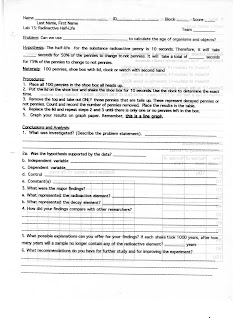

This is article 2. Be sure to use complete sentences to answer questions 1 and 2. Use blue or black ink or pencil. Be sure your GIST is exactly 15 words and reads across like a book. Use only one word per blank. DO NOT BEGIN...This article is about...


These are the lab sheets for lab 15. Be sure to print them out and complete them prior to the next class.
Using information from laboratory experiments, videos from the internet and classroom discussions,
Students should be able to:
-use a model to demonstrate the process of radioactive decay.
-hypothesize and test to determine the absolute age of a substance.
The do now was to write an acrostic poem about either: minerals, rocks, or fossils. The word is written vertically. The first letter of the word or phrase should be the letter of the word. Each line should be a description of the word. For example:
Rocks, made from 2 or more minerals
Once melted material, can harden to form new rocks
Cycled from one type to another
Keep changing over time by weathering and erosion
Some types are igneous, sedimentary, and metamorphic.
Home learning was collected and reviewed. Students also received article 2, which is due next class. The article can be found at the top of the blog.
We then saw BrainPop movies about radioactivity and carbon dating.
Students completed a model lab on radioactive half life. Since the lab can be done with materials found at home, those students that were absent can print out the sheets above and do the lab at home.
























